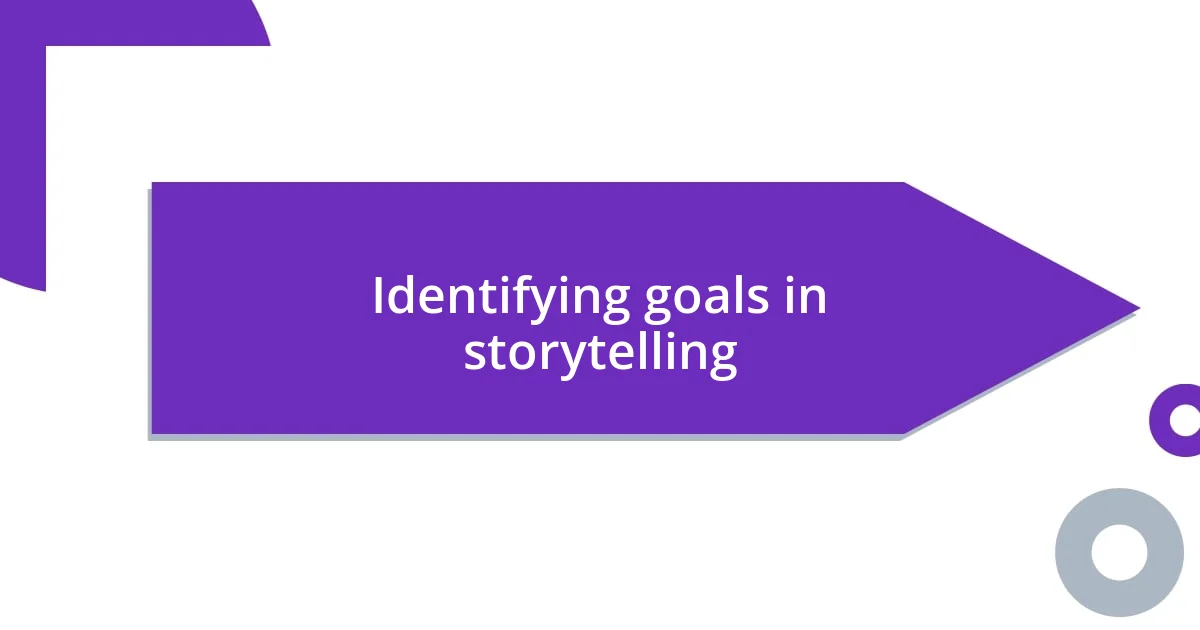Key takeaways:
- Character motivations are deeply influenced by their desires, fears, and backstories, which enrich the narrative and enhance relatability.
- Identifying clear goals and emotional drivers in characters creates compelling arcs and engages the audience, allowing for personal connections to the story.
- Understanding how motivations impact plot development ensures cohesive storytelling, making each character decision feel significant and inevitable within the narrative context.

Understanding character motivations
Understanding character motivations starts with recognizing their desires and fears. I often find myself empathizing with characters whose goals resonate with my own aspirations. For instance, a character striving for acceptance reminded me of the times I sought validation from my peers—it’s that universal longing to belong that often drives us, isn’t it?
As I reflect on my favorite stories, I notice that motivations are rarely black and white. They often reveal a mix of internal conflicts and external pressures. I remember watching a movie where the protagonist was torn between love and duty; it struck a chord because I once faced a similar choice in my life. It’s interesting how these conflicting motivations mirror our own experiences, making characters feel more authentic.
Additionally, understanding motivations can elevate our connection to a character. Have you ever cheered for the underdog? I frequently find myself rooting for characters who persevere against all odds, fueled by a deep-seated want to prove themselves. These moments of vulnerability and determination not only create tension but also provide insight into what truly drives a character, making their journey compelling and relatable.

Identifying goals in storytelling
Identifying goals in storytelling can be quite revealing. Whether they’re small ambitions or life-altering dreams, these goals are what push characters forward. Personally, I’ve found that when a character’s goal is clearly defined, it transforms the narrative into a gripping journey. Think about the moment when you realize a character’s deepest desire; it’s like a light bulb turning on. For instance, when I read a novel where the protagonist yearned to escape a suffocating environment, I felt a rush of understanding—who hasn’t wanted to break free from something limiting?
When analyzing character goals, consider these key aspects:
– Clarity of Desire: Is the goal straightforward or layered with complexity?
– Personal Stakes: What does the character stand to lose or gain?
– Conflict: What obstacles do they face on their path?
– Growth: How does pursuing their goal change them?
– Relatability: Can you connect their goals to your own experiences or aspirations?
Recognizing these elements not only enhances my reading experience but also deepens my appreciation for the meticulous craft of storytelling. It’s fascinating how a well-defined goal can resonate so personally, sparking a sense of shared longing or aspiration in its audience.

The role of backstories
Backstories play a crucial role in shaping character motivations and goals. They provide context and depth, helping us understand why a character behaves in a certain way. I often find that when a character’s backstory is revealed, it transforms their actions from puzzling to relatable. For example, I recently watched a series where a character’s troubled childhood explained their intense fear of intimacy. This insight not only enriched their personality but also made their journey towards love feel profoundly compelling.
Delving into backstories can also highlight the complexities behind a character’s motivations. I remember reading a book where the protagonist’s strained relationship with their parent drove their relentless ambition. It struck me how seamlessly the author wove this backstory into the narrative, making every decision the character made feel justified. This nuance is essential; it reminds us that motivations often stem from past experiences, making understanding them crucial for a more impactful storytelling experience.
Moreover, backstories often serve as a blueprint for character growth. When I see a character overcoming their past mistakes, it ignites a spark of hope in me. There’s something so human about witnessing their struggles and triumphs. For instance, I resonated deeply with a character who escaped a toxic environment, as it reminded me of my own journey towards self-discovery and empowerment. It’s these layers of backstory that enrich the narrative and allow readers to connect emotionally.
| Elements of Backstories | Importance |
|---|---|
| Character History | Shapes motivations and enhances relatability. |
| Emotional Wounds | Creates depth and complexity in decisions. |
| Transformational Journey | Demonstrates character growth over time. |

How emotions influence motivations
Emotions serve as a powerful compass for motivations, often driving characters more than mere goals. I’ve noticed that a character’s feelings—whether it’s love, fear, or anger—can create an urgency that shapes their choices. For instance, I once immersed myself in a novel where a character pursued their dreams out of sheer desperation after losing a loved one. This deep, emotional driving force not only propelled the plot but also made me feel their longing on a personal level.
When I reflect on my own experiences, I realize how often my emotions dictate my motivations. There have been times when sadness pushed me to create art as an outlet or when joy sparked a desire to connect with others. Similarly, in storytelling, when characters are motivated by strong emotions, it adds layers to their journey, making it resonate deeply with us. Think about it: how many times have you watched a film and felt gut-wrenching empathy for a character whose fears drove them to reckless decisions? It’s this emotional connection that makes their journeys all the more compelling.
Moreover, emotions can lead to conflicting motivations, creating rich internal struggles. I recall a story where the protagonist faced a dilemma between following their heart and adhering to family expectations. This tug-of-war between love and duty felt so relatable to me. Haven’t we all experienced a moment where our wants clashed with what’s expected of us? Those emotionally charged conflicts not only advance the narrative but also invite us to reflect on our motivations. Understanding this dynamic can pave the way for a deeper appreciation of characters and their often tumultuous paths.

Creating believable character arcs
Creating believable character arcs is about crafting journeys that feel authentic and resonate with the audience. I’ve learned that the most impactful arcs often start with relatable goals. For instance, when a character wants to prove themselves or find love, it’s easy to connect with their desires. Isn’t that what drives us all? Those simple yet profound goals can serve as a foundation for a character’s development.
As characters encounter challenges and evolve, their arcs become richer. I remember a tale where the protagonist initially chased fame, but through struggles and failures, they discovered the importance of genuine relationships. Witnessing that transformation was not just satisfying; it mirrored my own life experiences where I chased superficial dreams only to realize fulfillment lay in deeper connections. Does this resonate with you? Reading such arcs makes me reflect on how goals can shift, revealing the layers of our true selves.
Additionally, the pacing of a character’s growth matters significantly. Too rapid, and it feels contrived; too slow, and it loses impact. I encountered a series where the character’s gradual realization of their potential had me rooting for them every step of the way. When I see characters stumble, learn, and rise again, it’s like a mirror reflecting my challenges and triumphs. Isn’t it uplifting to see struggle leading to growth? Balancing those elements ensures that character arcs feel not only believable but also relatable.

Tips for developing characters
Developing characters is like painting a portrait—each brushstroke reveals deeper layers. One tip I’ve found invaluable is to define your characters’ core motivations clearly. For example, think about the character I wrote about who was driven by a need for acceptance. As I was crafting her story, I realized my own quest for belonging often influences my choices too. Isn’t it fascinating how often our characters reflect our struggles?
Another essential aspect is to give your characters flaws. I’ve noticed that imperfections can create a relatable and engaging narrative. There’s something about a character who stumbles yet continues to strive that really resonates with me. In a story I recently read, the protagonist grappled with self-doubt while chasing a seemingly unattainable dream. This internal battle not only added depth but also made me root for her. Have you ever found yourself drawn to a character because they mirrored your own vulnerabilities?
Lastly, consider the relationships that shape your characters. I believe that the connections they build—or even the tensions they experience—can drive their development. Like when I wrote about a character who was at odds with their mentor, I found parallels in my own life. The challenges of navigating conflicting guidance have taught me resilience. Isn’t it true that relationships can profoundly affect who we become? By exploring these dynamics, we can craft more relatable and profound characters.

Applying motivations to plot development
Understanding how character motivations can influence plot development is crucial. For me, it often feels like watching a dance; the motivations lead the rhythm, guiding the character’s steps through the storyline. Take, for instance, a character driven by revenge. Their relentless pursuit not only shapes their decisions but also creates tension and conflict in the narrative. I always find myself on the edge of my seat, wondering how far they’ll go to achieve their goal. Have you ever been captivated by a character’s obsession and felt the suspense build, almost as if you were alongside them in their journey?
When motivations shift or evolve, they can significantly alter the direction of a plot. I once read a story where the hero began with a narrow focus on wealth but gradually realized that true happiness lay in helping others. This shift wasn’t just a plot twist; it felt like a profound revelation. It made me ponder how our own motivations can change based on life experiences. Have you noticed similar patterns in your own life, where a sudden insight transformed your perspective?
Moreover, integrating character motivations into the plot ensures that the story feels cohesive. I recall crafting a narrative where a character’s longing for freedom intertwined beautifully with the unfolding events around them. Each choice they made resonated with their deep-rooted desire, tying their personal journey to the overarching plot. Isn’t it fascinating when character goals align so seamlessly with the narrative that every moment feels inevitable? That’s when storytelling reaches its pinnacle, creating a rich experience that lingers long after the last page.














